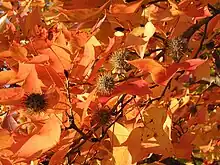Liquidambar formosana
Liquidambar formosana, commonly known as the Formosan gum, Chinese sweet gum and Formosa sweet gum,[1] is a species of tree in the family Altingiaceae native to East Asia.
| Liquidambar formosana | |
|---|---|
 | |
| Liquidambar formosana in autumn | |
| Scientific classification | |
| Kingdom: | Plantae |
| Clade: | Tracheophytes |
| Clade: | Angiosperms |
| Clade: | Eudicots |
| Order: | Saxifragales |
| Family: | Altingiaceae |
| Genus: | Liquidambar |
| Species: | L. formosana |
| Binomial name | |
| Liquidambar formosana | |
Description
Liquidambar formosana is a large, native, deciduous tree that grows up to 30-40m tall. The leaves are 10~15 cm wide.,[2] and are three-lobed unlike five- to seven-lobed leaves of most American Liquidambar species.[3] The foliage of the L. formosana turns a very attractive red color in autumn.[4] Leaves grow in an alternate arrangement, and are simple, palmately-veined, with serrated margins. Roots can be aggressive and branches are usually covered with corky projections. The individual flowers of L. formosana are unisexual. However, both sexes can be found in the same plant (monoecious).[5] Male flowers are in catkins, female flowers form dense spherical heads, and the fruit is burr-like because of the persistent styles.[4]
Distribution and habitat
Liquidambar formosana grow mostly in woodland in warm temperate zones. It requires moist soil and can grow in light to no shade areas.[1] It is usually found in East Asia in Central and Southern China, Taiwan, and Indochina.[2]
Uses
Medicinal
Liquidambar formosana has many medicinal uses. The leaves and roots are used in the treatment of cancerous growths. The stem bark is used in the treatment of fluxes and skin diseases. The fruits used in the treatment of arthritis, lumbago, oedema, oliguria, and decreased milk production and skin diseases. The resin from the stems is used to treat bleeding boils, carbuncles, toothache and tuberculosis. The trunk of this tree can be used for aromatic resin.[1] The extract of this resin is used to promote blood circulation and relieve pain.
Other uses
Liquidambar formosana is rare in cultivation but in its native regions the wood is used for making tea chests and the leaves to feed silk worms.[2]
Gallery
 Fall foliage and seed pods
Fall foliage and seed pods_(22085141600).jpg.webp) Bark detail
Bark detail_(23193757901).jpg.webp) Foliage
Foliage Viscum articulatum on the Liquidambar formosana. Taiwan.
Viscum articulatum on the Liquidambar formosana. Taiwan.
References
- "Liquidambar formosana-Hance". Plants for a Future. Retrieved 26 April 2012.
- Hora, Bayard (1981). The Oxford Encyclopedia of the Trees of the World. Oxford University PRess. pp. 182, 183. ISBN 978-0-19-217712-4.
- Straley, Gerald (1992). Trees of Vancouver: A Guide to the Common and Unusual Trees of the City. University of British Columbus Press. p. 128.
- "Tree Conservation". Archived from the original on 8 October 2014. Retrieved 26 April 2012.
- Jackes, Bethsy. "Liquidambar formosana". James Cook University. Retrieved 2 April 2016.